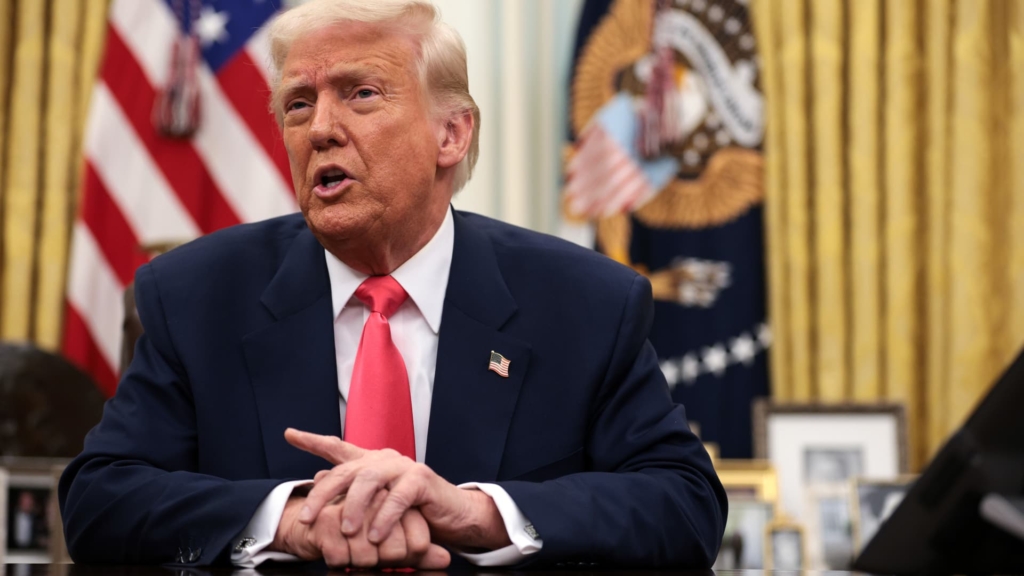President Donald Trump has confidently stated that tariffs will enrich the United States. However, economic experts caution that the anticipated financial windfall may fall significantly short of the White House’s optimistic projections.
According to analysts, the implications of these tariffs extend beyond just immediate revenue, potentially affecting the overall U.S. economy, national debt levels, and ongoing debates regarding a tax-cut initiative.
White House trade advisor Peter Navarro recently suggested that tariffs could generate approximately $600 billion annually, totaling $6 trillion over a span of ten years. He also indicated that auto tariffs could contribute an additional $100 billion per year during his appearance on “Finance Newso News Sunday.”
This forecast coincides with the U.S. government’s upcoming announcement regarding more tariffs on various trading partners, scheduled for Wednesday.
Despite Navarro’s bullish assertions, many economists believe the actual revenue generated from the Trump administration’s tariff policies will be considerably less. Some experts predict it could be less than half of Navarro’s estimates.
Mark Zandi, chief economist at Moody’s, expressed skepticism, stating that the $600 billion to $700 billion annual figure is “not even in the realm of possibility,” proposing that reaching a range of $100 billion to $200 billion would be a substantial achievement.
The White House has not publicly commented on inquiries from Finance Newso regarding the expected revenue from tariffs.
The ‘mental math’ behind tariff revenue
There are significant uncertainties surrounding the proposed tariffs, including their scale, duration, and the specific products and countries that would be affected. These factors will heavily influence the overall revenue outcomes.
Reports suggest that a 20% tariff on most imports is being considered, a concept that Trump had previously floated during his campaign. The administration may ultimately adopt different approaches, such as implementing country-specific tariffs based on various trade barriers.
Economists noted that a 20% tariff rate aligns with Navarro’s revenue expectations. The United States imported nearly $3.3 trillion worth of goods in 2024, suggesting that a flat 20% tariff could yield around $660 billion annually.
“That appears to be the mental arithmetic Peter Navarro is relying upon—though it overlooks several crucial factors,” commented Ernie Tedeschi, director of economics at the Yale Budget Lab and a former chief economist under the Biden administration.
A comprehensive revenue estimate must consider the multiple economic repercussions of imposing tariffs both domestically and internationally, experts emphasized. These ramifications can significantly lower expected revenue.
Taking those effects into account, Tedeschi argues that a broad 20% tariff would more realistically generate around $250 billion annually ($2.5 trillion over ten years), according to a recent analysis by the Yale Budget Lab.
To achieve higher revenue figures, economists suggest implementing steeper tariff rates. For instance, a hypothetical 50% across-the-board tariff could result in approximately $780 billion in annual revenue, as per assessments from the Peterson Institute for International Economics.
However, this estimate is also considered optimistic since it fails to factor in the potential decline in U.S. economic growth due to retaliatory measures and the negative impacts of the tariffs themselves.
Why revenue would be lower than expected
It is widely understood that tariffs typically lead to increased consumer prices. The Yale Budget Lab has estimated that a broad 20% tariff could impose an extra cost of $3,400 to $4,200 per year on the average consumer.
With prices rising, there is a natural expectation for consumers to purchase fewer imported goods, which would consequently drive down demand and reduce tariff revenue.
Moreover, tariffs are anticipated to result in diminished economic activity, according to Robert McClelland from the Urban-Brookings Tax Policy Center.
More from Personal Finance:
Experts warn that ‘value-added taxes’ do not constitute a trade barrier
They assert tariffs are detrimental to U.S. jobs and industry
Uncertainties are causing volatility in the stock market
For example, U.S. companies that choose not to transfer the costs of tariffs onto consumers by raising prices may see a decline in profits, adversely affecting their income taxes. Reduced consumer spending could exacerbate the situation, leading to company layoffs.
Foreign nations may also respond with tariffs on U.S. exports, which would negatively impact American companies selling abroad. Economic downturns in other countries could further diminish demand for U.S. products.
“Implementing a 20% tariff will likely trigger a major recession, undermining any fiscal benefits,” warned Zandi.
Additionally, economists expect some level of non-compliance with tariffs, as well as exemptions for specific countries or products. For example, during recent tariff implementations against China, the White House excluded certain “de minimis” imports valued at $800 or less indefinitely.
It is likely that the Trump administration may allocate some tariff revenue to compensate entities affected by the trade war, similar to actions taken during his first term when $61 billion in “relief” payments were issued to American farmers facing retaliatory tariffs, which accounted for a substantial percentage of the tariff revenue collected from 2018 to 2020.
Moreover, many economists foresee limited longevity for the tariffs, which would dilute their potential revenue impact. Since these tariffs are being established through executive orders, they could easily be revoked, either by Trump or by future administrations.
“The likelihood of these tariffs remaining in effect for ten years is virtually nonexistent,” Zandi remarked, adding that he would be surprised if they last until next year.
Why this matters
The Trump administration has indicated that tariffs will be a key mechanism in offsetting the costs associated with a potential tax-cut package, according to Tedeschi.
Even extending a tax cut law enacted in 2017 may incur a cost of $4.5 trillion over the next decade, according to the Tax Foundation. Trump has also proposed additional tax breaks, including exemptions on tips, overtime pay, Social Security benefits, and deductions for auto loan interest on American-made vehicles.
Should tariffs fall short of covering the full expenses of such a tax package, Republican lawmakers will need to identify alternative budget cuts or will face an increase in national debt, economists caution.


























